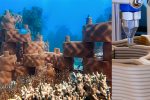
3DPRINTINGINDUSTRY.COM
WASPs innovative sustainable 3D printing showcase at Formnext 2024
Italian 3D printing company WASP has unveiled a range of sustainable technologies at this years Formnext tradeshow.These new developments aim to address environmental concerns and enhancing efficiency in architecture, manufacturing, and design. With over a decade of research, the companys latest developments prioritize material reuse, precision, and sustainable construction methods. Key highlights included a comprehensive recycling station for plastics, a dynamic multicolor extrusion system, large-scale 3D printing solutions, and developments in construction.3D printed column using geopolymer as a material. Photo via WASP.A focus on sustainabilityWASP has consistently focused on integrating environmental responsibility during 3D printing. This year, Institute for Advanced Architecture of Catalonia (IAAC) researchers constructed a 100 m low-carbon building prototype using a Crane WASP 3D printer at the 3D Printed Earth Forest Campus in Barcelona.Locally sourced soil and natural materials served as feedstock for the project, which aims to address the global housing shortage and reduce construction-related CO emissions. Designed with lightweight walls that regulate temperature and allow natural ventilation, the structure advances sustainable construction practices.Earlier contributions include the TECLA eco-friendly house, designed in partnership with Mario Cucinella Architects and constructed using recyclable materials. Developed as a prototype for sustainable housing in 2021, the structure utilized natural resources like local soil, layered into a self-supporting design.Synchronized 3D printers were employed to minimize energy consumption and human intervention. Construction of the dome-shaped buildings required 200 hours, 60 cubic feet of material, and just 6 kW of energy.At this years Formnext tradeshow, WASP showcased a computational column developed with Eindhoven University using 3D printed geopolymer modules, replacing clay to reduce energy usage and shrinkage. These modules also support plant growth and wildlife habitats, emphasizing environmental compatibility.Reducing CO emissions by up to 80%, these materials maintain chemical and mechanical durability even under extreme conditions. According to the company, geopolymers can be used as a sustainable alternative to traditional cement in construction.In addition, WASPs efforts in environmental restoration featured prominently in WASPs collaboration with rrreefs. Coral reef modules were printed live using WASP 40100 Production systems and Liquid Deposition Modeling (LDM) technology, showcasing a commitment to marine ecosystem regeneration.Designed to support biodiversity and provide coastal protection, these modules reflect a dual focus on ecological restoration and community involvement.Coral reef 3D printing in alliance with rrreefs. Photo via WASP.New products at Formnext 2024According to the company, years of research culminated in RIGENERA, a system designed to create a circular process for reusing plastic materials. This recycling station transforms waste and defective parts into functional components through tools that enable collection, shredding, and reprinting.Collection bins, a chainsaw for breaking down large pieces, a plastic shredder producing granules, and a dehumidifier preparing materials for printing all contribute to this system. These tools integrate with an HDP Printer or Extruder mounted on a robotic arm, guided by the CEREBRO system, to deliver a complete solution for waste management.Addressing color precision in 3D printing, METAMORFOSI introduces dynamic multicolor pellet extrusion. This system offers real-time control over color positioning, hue, and quantity using an app that manages pigment dosing.By utilizing cyan, magenta, yellow, and black pigments, this approach achieves seamless blending and vibrant outputs for tailored applications. Integration with AiBuild slicing software enhances its suitability for complex designs and high-precision workflows.For large-scale printing, POWER WASP 45 HDP Fused Granular Fabrication (FGF) 3D printer optimizes material usage and surface quality by employing a 45 printing angle.This unique approach minimizes support structure requirements, simplifies the production of complex geometries, and reduces issues like shrinkage and warping. Designed for applications in the marine and nautical sectors, the printer ensures reliable performance in demanding environments.WASP also launched the EXTRUDER HDP XXL, an extruder specifically developed for large-scale FGF applications. Equipped with High-Definition Pellet (HDP) technology, it enables direct printing with thermoplastic pellets and integrates seamlessly with robotic arms through the CEREBRO system.This extruder is also compatible with the RIGENERA extrusion system, allowing the use of 100% in-house recycled plastic shreds. Designed to process various plastic sizes, it incorporates a feature to remove metal impurities, making it suitable for demanding industrial tasks.With these developments, WASPs presence at Formnext 2024 showcased its focus to advancing sustainable practices and material efficiency in AM.Vote now in the2024 3D Printing Industry Awards!Catch up on all the news fromFormnext 2024.Want to share insights on key industry trends and the future of 3D printing? Register now to be included in the2025 3D Printing Industry Executive Survey.What 3D printing trends do the industry leaders anticipate this year?What does the Future of 3D printing hold for the next 10 years?To stay up to date with the latest 3D printing news, dont forget to subscribe to the 3D Printing Industry newsletter or follow us on Twitter, or like our page on Facebook.While youre here, why not subscribe to our Youtube channel? Featuring discussion, debriefs, video shorts, and webinar replays.Featured image shows coral reef 3D printing in alliance with rrreefs. Photo via WASP.Ada ShaikhnagWith a background in journalism, Ada has a keen interest in frontier technology and its application in the wider world. Ada reports on aspects of 3D printing ranging from aerospace and automotive to medical and dental.
0 Комментарии
0 Поделились
19 Просмотры


